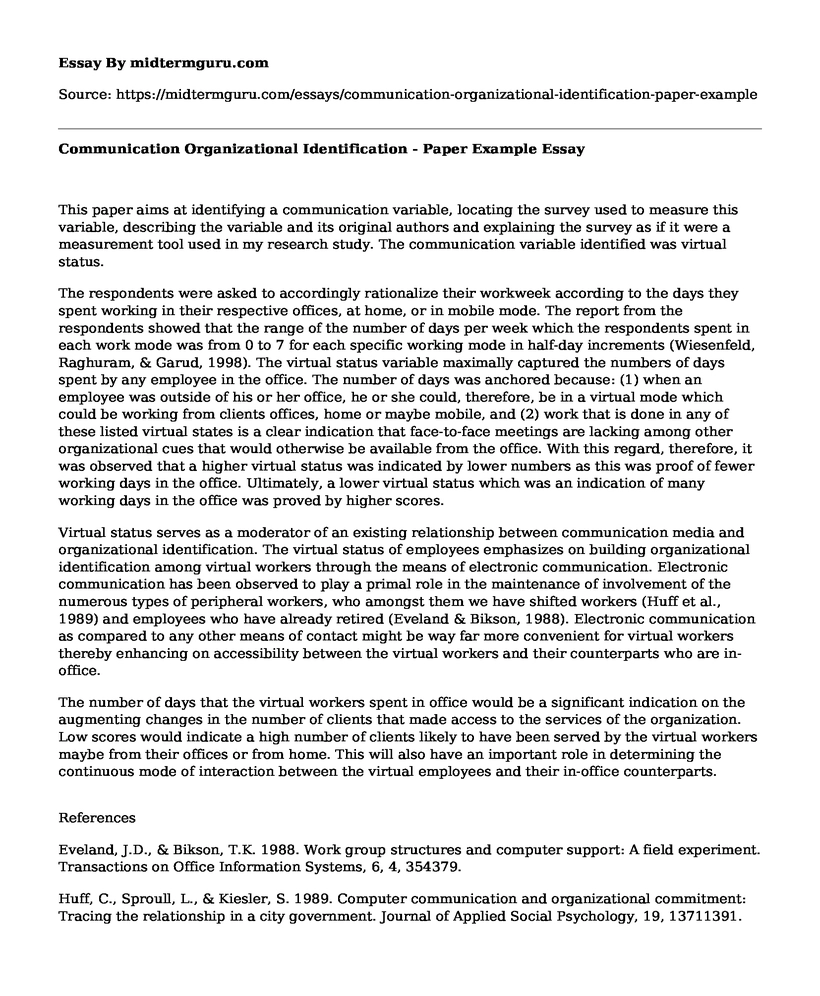This paper aims at identifying a communication variable, locating the survey used to measure this variable, describing the variable and its original authors and explaining the survey as if it were a measurement tool used in my research study. The communication variable identified was virtual status.
The respondents were asked to accordingly rationalize their workweek according to the days they spent working in their respective offices, at home, or in mobile mode. The report from the respondents showed that the range of the number of days per week which the respondents spent in each work mode was from 0 to 7 for each specific working mode in half-day increments (Wiesenfeld, Raghuram, & Garud, 1998). The virtual status variable maximally captured the numbers of days spent by any employee in the office. The number of days was anchored because: (1) when an employee was outside of his or her office, he or she could, therefore, be in a virtual mode which could be working from clients offices, home or maybe mobile, and (2) work that is done in any of these listed virtual states is a clear indication that face-to-face meetings are lacking among other organizational cues that would otherwise be available from the office. With this regard, therefore, it was observed that a higher virtual status was indicated by lower numbers as this was proof of fewer working days in the office. Ultimately, a lower virtual status which was an indication of many working days in the office was proved by higher scores.
Virtual status serves as a moderator of an existing relationship between communication media and organizational identification. The virtual status of employees emphasizes on building organizational identification among virtual workers through the means of electronic communication. Electronic communication has been observed to play a primal role in the maintenance of involvement of the numerous types of peripheral workers, who amongst them we have shifted workers (Huff et al., 1989) and employees who have already retired (Eveland & Bikson, 1988). Electronic communication as compared to any other means of contact might be way far more convenient for virtual workers thereby enhancing on accessibility between the virtual workers and their counterparts who are in-office.
The number of days that the virtual workers spent in office would be a significant indication on the augmenting changes in the number of clients that made access to the services of the organization. Low scores would indicate a high number of clients likely to have been served by the virtual workers maybe from their offices or from home. This will also have an important role in determining the continuous mode of interaction between the virtual employees and their in-office counterparts.
References
Eveland, J.D., & Bikson, T.K. 1988. Work group structures and computer support: A field experiment. Transactions on Office Information Systems, 6, 4, 354379.
Huff, C., Sproull, L., & Kiesler, S. 1989. Computer communication and organizational commitment: Tracing the relationship in a city government. Journal of Applied Social Psychology, 19, 13711391.
Wiesenfeld, B. M., Raghuram, S., & Garud, R. (1998). Communication patterns as determinants of organizational identification in a virtual organization. Journal of ComputerMediated Communication, 3(4), 0-0.
Cite this page
Communication Organizational Identification - Paper Example. (2021, Jun 04). Retrieved from https://midtermguru.com/essays/communication-organizational-identification-paper-example
If you are the original author of this essay and no longer wish to have it published on the midtermguru.com website, please click below to request its removal:
- Responses to Observation Letters on Personal Safety of Social Workers
- A Leader Versus a Manager - Paper Example
- Haiti Earthquake 2010 - Essay Sample
- AI Turing Test: Determining Human-Level Reasoning in Machines - Essay Sample
- Development Models in Leadership: Categorizing Managers and Employees - Essay Sample
- Essential Resource: Optimizing Employee Collaboration for Production - Essay Sample
- Project Management and Performance of a Company - Paper Example







